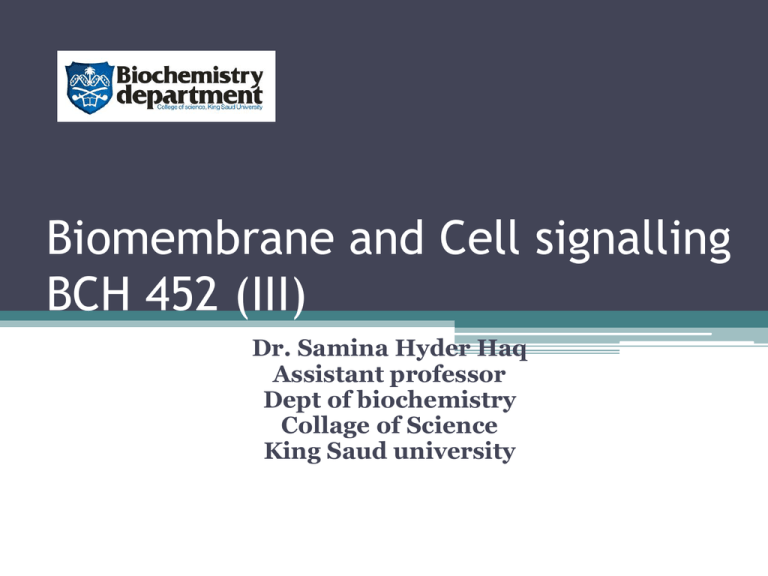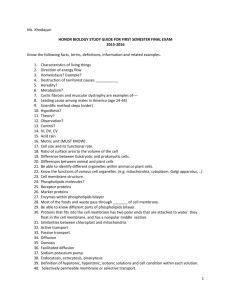Biomembrane and Cell signalling BCH 452 (III)
advertisement

Biomembrane and Cell signalling BCH 452 (III) Dr. Samina Hyder Haq Assistant professor Dept of biochemistry Collage of Science King Saud university Fluid Mosaic Model The Current model of Biomembrane. • Proposed in 1972 by SJ.Singer & G. Nicholson. • Membrane is a mosaic of protein molecule bobbing in a fluid bilayer of phospholipids. • Membrane is held together by hydrophobic interactions Proteins interacts with the membrane in three ways, 1. Integral membrane Proteins. 2.Lipid anchored membrane proteins 3. Peripheral Membrane proteins. Integral proteins or trans-membrane proteins Made up of 3 segments. outer and inner The cytosolic and exoplasmic domains have hydrophilic exterior surfaces that interact with the aqueous solutions on the cytosolic and exoplasmic faces of the membrane. They are like water soluble proteins in their amino acid composition and structure. middle the 3-nm-thick membrane-spanning domain contains many hydrophobic amino acids whose side chains protrude outward and interacts with the phospholipids layer. Lipid anchored membrane proteins. Bound covalently to one or more lipid molecules. The hydrophobic carbon chain of the attached lipid is embedded in one leaflet of the membrane and anchors the protein to the membrane. The polypeptide chain itself does not enter the phospholipid bilayer. Peripheral membrane Proteins. • They are usually bound to the membrane indirectly by interactions with integral membrane proteins or directly by interactions with lipid head groups. Peripheral proteins are localized to either the cytosolic or the exoplasmic face of the plasma membrane. • In addition to these proteins, which are closely associated with the bilayer, cytoskeletal filaments are more loosely associated with the cytosolic face, usually through one or more peripheral proteins. Such associations with the cytoskeleton provide support for various cellular membranes. • They also play a role in the two-way communication between the cell interior and the cell exterior. Fluid Nature of membrane. • Phospholipids can drift laterally within the plane of membrane bilayer.(LATERAL movement) • Phospholipids can also move across the bilayer.(Flip Flop movement) Movement of phospholipids Migration of Protein in bilayer Cholesterol acts as a “temperature buffer’’. • The steroid cholesterol is wedged between phospholipids molecules in the plasma membrane of animal cells. • At warm temperatures (such as 37°C), cholesterol restrains the movement of phospholipids and reduces fluidity. • At cool temperatures, it maintains fluidity by preventing tight packing. Fluidity of the membrane Fluidity of the membrane depends on temperature and the type of phospholipids. At low temperature the membrane has gel like consistency and when heated it has fluid like consistency. Membrane rich in unsaturated fatty acids are more fluid as compared to the membrane containing saturated fatty acids. Because kink in the fatty acids chain prevent tight packing. Membrane are Amphipathic. • A typical biomembrane is assembled from phosphoglycerides, sphingolipids, and steroids. All three classes of lipids are amphipathic molecules having a polar (hydrophilic) head group and hydrophobic tail. • The hydrophobic effect and van der Waals interactions, cause the tail groups to self-associate into a bilayer with the polar head groups oriented toward water.







